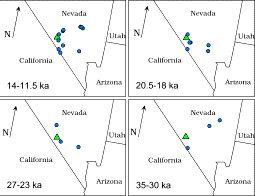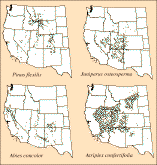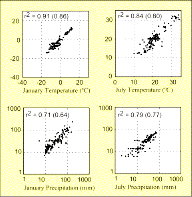

INTRODUCTION
Plant macrofossil assemblages recovered from packrat (Neotoma) middens of late Pleistocene age from the present-day Mojave Desert of southern Nevada contain plant species that today live at higher elevations and/or farther north than the midden collection sites. Previous reconstructions of late Pleistocene climates from packrat midden assemblages in this region (Spaulding, 1985) assessed the minimum climatic differences from today by estimating the present-day climatic differences between the fossil midden sites and the nearest current occurrences of key plant species recovered from the Pleistocene middens. From this approach Spaulding (1985) concluded that although late Pleistocene temperatures were considerably below those of today, only modest increases in precipitation (relative to today) were necessary for these plant species to survive in the current Mojave Desert during the late Pleistocene.
Spaulding's approach provided "state-of-the-art" results from an intensive careful examination of the best data available at the time. However, data and techniques developed since the mid-1980s suggest that there are two possible short-comings to this approach: 1) the use of lowest elevational and (frequently) most southerly occurrences of key plant species results in minimal estimates of the differences between Pleistocene and present-day climates, and 2) the instrumental climate data set available to Spaulding was limited in duration, non-standard in its method of collection, and indicated a modern climate wetter than the long-term historic mean, which resulted in relatively small apparent differences between late Pleistocene and present-day mean annual precipitation levels. In this report we use a more standard (close to the long-term mean) modern calibration period and a modern plant distribution data set that permits us to identify modern analogues for the Pleistocene vegetation. This reexamination permits a more robust reconstruction of the past climate, and results in estimates of mean annual temperature for the glacial maximum at Yucca Mountain that are 1.0° to 1.4° C warmer than those of Spaulding, and estimates of mean annual precipitation that are 60 mm or more higher than his.
In this report we use present-day climatic and vegetational data from across North America to estimate past temperature and precipitation values from plant macrofossil assemblages preserved in ancient packrat middens from southern Nevada. Our approach involves: 1) compiling a comprehensive list of plant macrofossil assemblages from late Pleistocene packrat middens of the region, 2) employing a ~25 km grid of present-day climate and plant distributions in North America (Thompson and others, 1999), and 3) applying numerical analysis that compared the North American data with the packrat middens to produce estimates of past climates. The following text describes each of these aspects in greater detail.
Plant Macrofossil Assemblages from Packrat Middens
Previous studies (e.g. Spaulding, 1985; Wigand and others, 1995) recovered numerous packrat middens from southern Nevada dating to the most recent period of continental glaciation during the late Pleistocene (~40,000 to 12,000 yr B.P. [~40 to 12 ka]). This report focuses on quantitative paleoclimatic interpretations of the plant macrofossil assemblages reported by Spaulding and Wigand, with particular emphasis on reconstructions of the climate from the last glacial maximum (LGM, ~18 ka). In addition to this interval, we also estimated the past climates for each of four intervals of the late Pleistocene (35 -30 ka, 27 -23 ka, 20.5 -18 ka, and 14-11.5 ka) that a panel of scientists from the Desert Research Institute (DRI), Dames and Moore (D&M), DOE, University of Colorado (CU) and the USGS selected as key times in the paleoclimatic history of the Yucca Mountain region (Figure 1). These time periods were selected based on previous paleoclimatic studies involving packrat middens, ostracodes, and other data sets that suggested that the climatic characteristics of each period were different. Initially, the period from 35-30 ka was thought to be the wettest interval of the late Pleistocene, and the 20.5 to 18 ka the coldest.
 Figure 1. (click to enlarge)
|
The late Pleistocene packrat middens from the Yucca Mountain region were collected from sites where today the plant cover is dominated by creosote bush (Larrea divaricata) and other plants adapted to the hot and dry current Mojave Desert. In contrast, packrat midden data indicate that during the late Pleistocene these sites hosted plants that today grow farther north and/or at higher elevations (including limber pine [Pinus flexilis], white fir [Abies concolor], Utah juniper [Juniperus osteosperma], big sagebrush [Artemisia tridentata], and shadscale [Atriplex confertifolia]; Figure 2). Collectively the modern distributions of these plant species imply that the late Pleistocene climate was cooler and wetter than that of today.
Present-Day Climate and Plant Distributions
 Figure 2. (click to enlarge)
|
| Scientific Name | Common Name |
|---|---|
| Ambrosia dumosa | white bur sage |
| Atriplex canescens | four-wing saltbush |
| Cercocarpus intricatus | little-leaf mountain mahogany |
| Chamaebatiaria millifollium | fernbush |
| Chrysothamnus nauseosus | rabbit brush |
| Colegyne ramosissima | blackbrush |
| Ephedra nevadensis | boundary ephedra |
| Ephedra viridis | green ephedra |
| Fallugia paradoxa | Apache plume |
| Purshia tridentata | antelope brush |
| Symphoricarpos longiflorus | snowberry |
| Symphoricarpos oreophilus | snowberry |
| Annual Temperature | Annual Precipitation | |
|---|---|---|
| PRESENT DAY | ||
| This study | 13.4° C | 125 mm |
| Spaulding, 1985 | 13.5° C | 189 mm |
| LAST GLACIAL MAXIMUM | ||
| This study | 7.9 to 8.5° C | 266 to 321 mm |
| Spaulding, 1985 | 6.5 to 7.5° C | 246 to 265 mm |
Estimation of Climatic Parameters from Vegetation Data
The inventory of fossil plant remains recovered from each packrat midden was compared with the plant list from each North American grid point to identify those grid points whose present-day vegetation is similar to the late Pleistocene vegetation found in the packrat midden (these modern sites are hereafter referred to as "analogues" for the Pleistocene packrat middens). The modern temperature and precipitation values at the analogue sites provide estimates for past climates in the region surrounding Yucca Mountain. We used the latter information to identify climatic patterns for selected past time periods by mapping the paleoclimatic estimates from multiple packrat midden fossil localities, and by plotting them against the geographic locations and elevations of the packrat midden sample sites. Climatic values for the late Pleistocene of Yucca Mountain were estimated by using the climate-elevation relations derived from this approach.
Modern analogue techniques, methods that identify sites where plants found in fossil assemblages are living today, are widely used to reconstruct past climates in eastern North America and Europe (for examples, see Overpeck and others, 1985 and Guiot, 1990). The fossil and the gridded modern vegetation data in this study are both presence-absence data. In order to obtain a measure of similarity between modern and fossil presence-absence data, we used the binary Jaccard matching coefficient (Jaccard, 1908; Schweitzer, 1994) to compare each packrat midden plant assemblage with each gridpoint within the modern data set. The Jaccard coefficient provides a measure of how similar each modern gridpoint assemblage is to the fossil assemblage, with a value of 0.0 indicating no shared species between the modern and fossil assemblages and a value 1.0 indicating that the two assemblages have exactly the same list of species.
 Figure 3. (click to enlarge)
|
Based on our experiments, we discarded potential modern analogues with Jaccard coefficients less than 0.3, and then selected the 200 analogues with the highest Jaccard coefficients above that value (if there were fewer than 200 analogues above that value, we used all of them). As higher Jaccard coefficients imply greater similarity between the modern and fossil vegetation than do low coefficients, we weighted the climatic data from the analogues by the ratio of the cubes of their Jaccard coefficients. Hence the climatic data from a modern sample with a Jaccard coefficient of 0.9 would be weighted approximately six times the data from a sample with a coefficient of 0.5 (0.93 = 0.73; 0.53 = 0.13; 0.73/0.13 = 5.62). This ensures that the modern sites with the greatest similarity contribute the most information to a given paleoclimatic estimate, while also allowing a broad examination of the potential climates that could account for the fossil vegetation.
We used the method described above with the present-day vegetation to estimate the modern climate at each of 80 grid points from the western interior of the United States where weather stations occur near the grid points (Figure 3). Regression analysis of the observed versus estimated January, July, and annual temperature at the grid points yielded r2 values of 0.84 to 0.91 for temperature, indicating that, at least in the present-day situation, this method provides very reliable estimates of temperature. The comparisons of observed and estimated modern January, July, and annual precipitation provided r2 values of 0.70 to 0.79 for precipitation and 0.71 to 0.80 for the log of precipitation. This indicates that our method produces somewhat less robust, but still acceptable, estimates of precipitation.
|
NEXT: Analogue-Based Paleoclimatic Reconstructions |
| AccessibilityFOIAPrivacyPolicies and Notices | |
| |
|